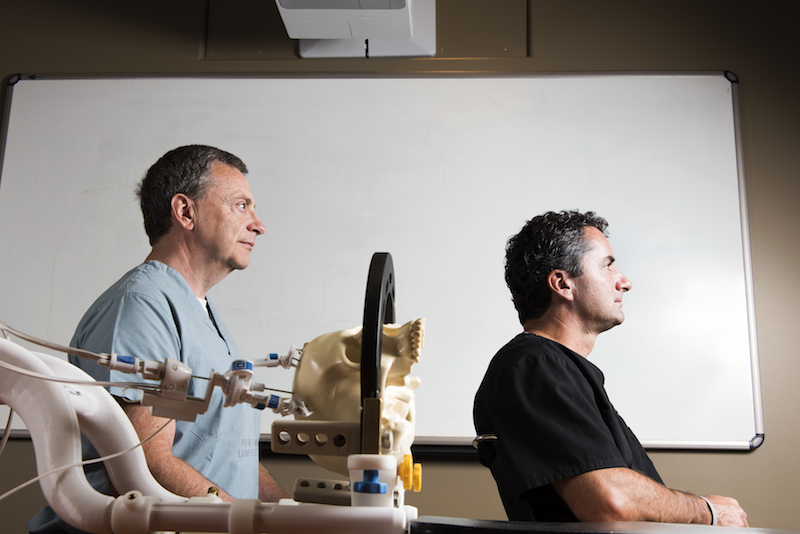
Mark Torchia (left) and Richard Tyc brought to market the Neuroblate, a device that is now saving lives across North America
Research in the classroom
When I think of how hard it was to convince people that a simple idea could in fact solve a complex problem, I’m reminded of something my 94-year-old Italian grandmother would tell me as a kid.
When I’d ask to come over to her house to see her, she’d respond: “Marco mio, who’s going to stop you?” It became our family’s go-to adage when we faced a roadblock in life.
This phrase carried me through my research journey to develop the NeuroBlate: a probe that delivers laser energy to obliterate brain tumours otherwise deemed a death sentence.
When I reflect on the experience, a few words come to mind: perseverance, excitement, frustration, collaboration, discovery. As a teacher, I hope I offer students an equally rich experience—one in which they feel engaged and inspired.
But how do we successfully bring our passion for research to the classroom and to our students? The most obvious way—and one we do almost automatically—is to weave our research findings into the subject matter we teach. As soon as I inject material not found in the textbook or notes packages, students take notice. It’s a great time to make a connection.
And I’ve learned it’s important to share more than just research successes. The negative outcomes are particularly fascinating to students and generate considerable discussion. Maybe we need to open this door more often. Because when we do, students often open up about their own struggles in learning. Suddenly, we’re connected on another level and I seem more like a person to them and less like a knowledge transmitter.
“If students believe they can solve or discover or cure then their coursework has greater meaning.” -Mark Torchia
As researchers, we spend a considerable amount of time creating and submitting grant applications. SSHRC, CIHR, NSERC deadlines—who needs them marked in a calendar? They’re seared into memory. Why not turn this frustration into an active learning opportunity? How about an open grant competition for the class?
One year, with the support of the Heart and Stroke Foundation, I divided my class of 115 students into 10 groups, narrowed the topic down (Primary Prevention of Heart Disease in Manitoba: A Community-Based Approach) and had them work together to create a grant application, complete with a budget and knowledge translation plan. For this final assignment, grades were handed out and a review panel ‘awarded’ three grants. In our reviews, we didn’t focus heavily on research methodology but rather on novelty, engagement, and realistic chances for implementation. I have never seen a class work so hard to ‘win’ the grant. Not only did they enjoy the competition, they learned beyond conventional coursework and better understood what we do as researchers.
For many of us, our path into research comes from our desire to make a difference. If students believe they can solve or discover or cure, then their coursework has greater meaning. It’s difficult for students sitting in a classroom to feel they’re making an impact through their learning. Yet research shows intrinsic motivation is a key factor of student engagement and success. Service-learning opportunities are a great way to empower students and have them learn beyond the class and campus. Experiences like these help students connect what they learn in their textbook or in a lecture or PowerPoint slideshow with the needs of the real world.
Or how about turning your classroom into one of your own research projects? Even a project that could receive funding, produce strong evidence and result in meaningful publications. As teachers, who among us hasn’t asked: “Why are the students not grasping this concept?”, “How can I make this more engaging?”, “Why do students feel so angry about the exam or assignment?”
Turning your classroom into a research environment through action research not only allows you to generate new knowledge and add evidence to your teaching portfolio, but if the design allows, you can also engage students in the research process. They become partners in the inquiry. They’ll experience the ups and downs of research and the excitement of discovery. Best of all—they’ll begin to understand that no one can stop them.






